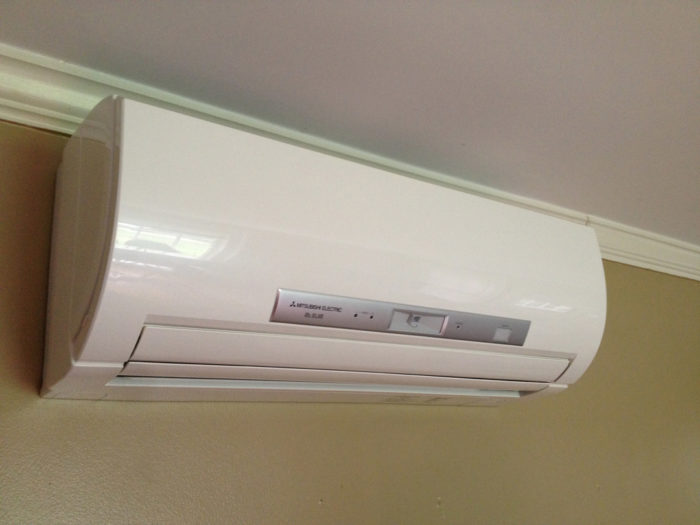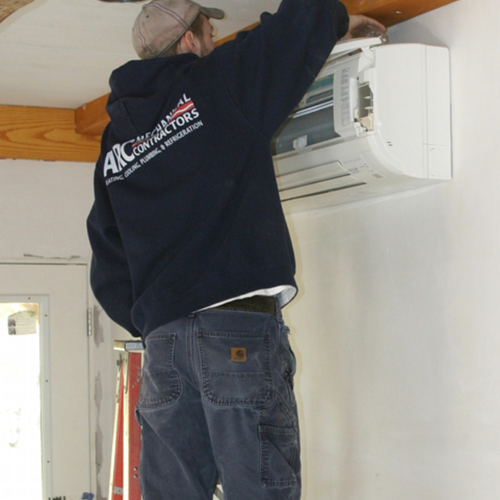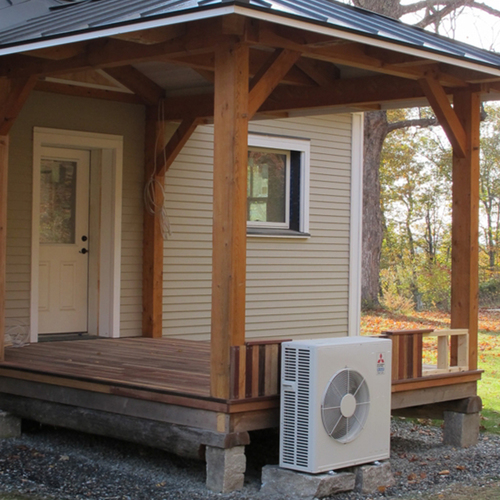Image Credit: Carl Seville
Image Credit: Carl Seville I look at this combination thermometer/hygrometer regularly. Taking into account the outdoor temperature and my personal comfort needs, I then decide when to close up my house and turn on the HVAC.
Last year, still living in my little cottage due to delays and problems attempting to build a new house in my historic district, I finally got tired of the old gravity floor furnace and window air conditioners and decided to spring for a new HVAC system. I looked briefly at installing a central ducted system, but I realized that I had really enjoyed the zone control that the window units had afforded me.
My cottage is moderately well insulated and air sealed for an almost 100-year-old house. At only about 750 square feet, the house has a total load of only about 1.5 ton. I looked at high-performance ducted heat pumps, standard gas furnaces, and both ducted and ductless minisplits.
I ultimately selected Mitsubishi ductless models because they would give me the same zone control I had with my window units, and they were the most efficient equipment available (rated at 26 SEER and 10 HSPF). I installed three separate units, each with its own outside condenser, instead of a single large condenser for all three interior units.
Interestingly, there was almost no cost difference between the single and multi-head systems, and the one-to-one models have a higher rated efficiency.
Making good use of high-performance equipment
Although it may not seem so compared to some of the world-class energy geeks who inhabit this site, I get pretty deep into the weeds when it comes to managing my HVAC systems. Even here in the sunny South, I don’t use my air conditioning very much, preferring to open windows and doors when the temperature and humidity are manageable, then closing the house up as the day heats up.
I often don’t turn on the AC until late in the afternoon, and then usually turn it off again and open things up as the outside temperature goes back down. This has worked well through most of the year, although there are some days in July and August when the house stays closed up most or all of the day.
I have the luxury of working at home most of the time, so I can track the temperature, turn things on and off, and open windows as necessary, and I can dress as lightly as I want in order to stay comfortable. Even my only moderately well air sealed house tends to hold the temperature and humidity fairly constant when closed up. This wouldn’t be the case if I lived in Minnesota or some other insanely cold place, but it’s pretty moderate most of the time down here in Georgia.
You keep it how warm?
Some people, especially Southerners who have become accustomed to full-time air conditioning, can’t believe that I keep my house at about 80° to 82°F (and, occasionally, even higher) for most of the summer. I work and sleep under a ceiling fan, and I now find that I feel almost cold when the air conditioning is running full-time.
I feel particularly smug (not a challenge for me) when my windows are open on a beautiful day or night, and can hear my neighbor’s heat pump running – in both the winter and the summer. I can’t imagine what they are spending on their energy bills.
When I have guests, I usually set the temperature to a more socially acceptable level, and if I didn’t live by myself, I would probably have to make some changes. But, for now, at least, I have the “luxury” of being an energy curmudgeon and keeping the house warmer and colder than most people would accept.
Weekly Newsletter
Get building science and energy efficiency advice, plus special offers, in your inbox.
















14 Comments
Boy I wish I was around for that HP article
because as a historic preservation professional and sustainability coordinator I would have given you my two cents.
Do tell
Please share your two cents. I did get a house approved finally but elected to not build it for a variety of reasons. after my first unsuccessful preservation meeting, I stopped attending and sent an architect to be my representative at all the meetings. I was worried I might go postal and injure someone
I Guess I Would Like My Minis Too If
I didn't even use them, ah, like it sounds like you are not even using yours. If you like it so hot, and, apparently can stand the humidity, why even have AC?
I live in Maryland and got a Fujitsu 12RLS2 and a 9RLS2 (for upstairs), for a total of 21k btu/hr, in Febrruary. Tbis is about half my old load before I superinsulated and tightened up my 1440 sq. foot house. Wow, I was impressed with the heating capability of the units. They put out hot air, and I never felt hot air out of the central system I TOOK OUT, unless the resistance heat was running.
As much as I was impressed with the heating, I am totally disgusted with the cooling performance (actually the water removal) of these Fujis. The units can make the house cool enough, but they really suck for water removal. The 12RLS2 unit claims 3.8 pints per hour and the 9 claims 2.7 pints. I have tested each unit several times under several conditions, including those stated by Fuji, and I have never seen more than 1 pint per hour out of the 12 and 7 oz. out of the 8 unit. This is totally inadequate for Maryland and the inside humidity is well above comfort level. There is plenty of heat to remove and they run constantly, so don't tell me they don't get to cycle enough to remove water. If these units dehumidify the way Fujitsu says they can, then I believe the humidity level would be fine. I got absolutely no help with this problem from the HVAC contractor I used.
Confused
With 750 square feet, why did you need THREE ductless minisplits? It seems as though one unit would be more than sufficient. The cost of three units installed would be around $5k or more.
Responses to Sonny and Peter
Sonny - I agree with your point about how well mini splits heat - the air coming out of them actually feels warm, unlike traditional split system heat pumps that need strip heaters. I find that the cooling and dehumidification are excellent . The Mitsubishi units have both a traditional cooling cycle and a dehumidification setting which doesn't have temperature control. I have tried both, and every time it drops the RH by about 20% very quickly, and when in AC mode, the temperature is easily managed as well as humidity controlled. I haven't yet measured the amount of water coming out of the condensate line, I judge their performance by how it affects the RH and temperature inside.
I can stand the humidity, but I do control it when necessary. When it goes over 80 inside, I often close up the house, turn on the cooling or dehumidification setting to make it more comfortable, then turn it off after a while, often opening up the house in the evening if it is comfortable outdoors. Interestingly, when the temperature is at 78 or lower and RH below 50 I actually start to feel a little cold, but then I guess I'm just weird.
Peter - I elected to install 3 heads to give me good room by room control. Their total capacity is well over what the house needs, but since they run a variable speed, they are almost always running on low speed and provide excellent heating and cooling. While my roof and floor are well insulated, my walls have no insulation and most of my windows are old single glazed double hungs. Since they are wood lap siding with no sheathing, I am reluctant to install any blown in insulation as I am concerned that is would create moisture problems in the wall in my wet climate. Also, being in a historic district, it would be complicated and very expensive to remove all the siding, insulate, add sheathing, a weather barrier, remove and reinstall all the windows with flashing. I certainly could have spent less on a single ducted system for the entire house, but I would have sacrificed the room control and the opportunity to experiment with this type of technology.
I think there is an opportunity for a manufacturer to produce smaller units for the US market. Allison Bailes and I visited with Mitsubishi a few years back and we suggested that they consider developing a model that would fit inside interior walls for our market - they listened, but I'm still waiting to see if they do something like this.
Construction pics of ducted mini-splits?
I would be very interested in an article (or links to existing articles) that focused on the design and installation of ducted mini-split systems. For example I've heard that people put them in the top of closets, but I'm unsure what the ducting looks like for that.
I've found a few examples:
http://www.proudgreenhome.com/article/212651/Ducted-mini-split-heating-and-cooling-from-LG-for-the-Proud-Green-Home-at-Serenbe
but a lot of these tend to show quite long duct runs, rather than very short ones. For example, the comment above suggests "in-wall" units. I'm assuming that some people have done very short duct runs with ducted mini-splits, perhaps in false walls or dropped soffits, I'd love to see some examples.
I've also heard that people have tried hiding the ductless head units in various ways, but that those are often not successful, I'd love to know more about that.
Response to James Howison
James,
Q. "I've also heard that people have tried hiding the ductless head units in various ways, but that those are often not successful. I'd love to know more about that."
A. Bob Alsop has posted some photos of his cabinet (a custom cabinet with a louvered door designed to hide a ductless minisplit unit) on the following Q&A thread:
https://www.greenbuildingadvisor.com/community/forum/energy-efficiency-and-durability/27835/ducting-ductless-minisplit#comment-57370
Inverted Tree Frogs
I just got a new LG 28 seer mini split this spring. It stopped working today and my trained nose told me the smoke had poured out from within. Turned out a couple of tree frogs got onto the inverter board and shorted it out. I've never had this problem with my conventional mini split. I'm stumped for what to do to stop it from happening again. I'm hoping LG will replace this one under warranty but then what?! Build a cage around the outdoor unit and keep a hognose snake in there? What happens when it gets full and can't eat any more frogs?
This author claiming Georgia is moderate is talking crazy talk. The part of south Georgia where I live is a brutal jungle of creepy crawlies with a tenacious desire to slip their highly conductive amphibious asses into my expensive electronics. I keep my house sealed up like an ice chest.
Tough frogs
Too bad about the electrocution problem with your equipment. Good luck. As to the moderate climate comment, Atlanta really is different than the southern part of the state. At 1000 feet above sea level we don't get that Deep South humid heat as much or for as long. I've noticed that although summer is longer temperatures tend to be lower than much of the country. During recent heat waves we have had cooler weather than many Midwest and northern states.
re Sonny
It took me a minute then I realized you stated you superinsulated your house.
I think I know the answer.
The inside units on most minisplits never shut off. The outside units will however if there is no cooling load. My guess is that the minisplits are effectively oversized, cool the house easily and then shut off, before dehumidifying. If there is a dehumidify setting try it. Play with fan settings, the computer is not as smart as it thinks it is. The dehumidify setting may drive the room temp below what is comfortable. Try also using standard mode with the fan set on low, which should be similar to dehumidify mode but shouldn't lower the room temp.
I have been living with mitsu mini splits in two houses for 7 seasons and love them, but they are not perfect
Thanks Keith for responding
Keith, what is your climate (humidity!) zone?
I believe there is plenty of cooling load in my house. I've done 3 tests so far on each unit--2 one-hour tests and one 2-hour test. Neither the inside or outside units stopped. They run so slow, though, that it makes you feel like they aren't doing much. They aren't, when it comes to water removal. The "dehumidify" setting you say to try is what it was on for all tests. Fujitsu calls it the "dry" setting, that claims to "dehumidify while gently cooling." There is no fan control if you use this setting--it just runs slow, as well as the outside fan. I haven't tested in the regular mode with "low" fan setting, but I have run them that way and it seems like no difference from the "dry" mode. We run a dehumidifier upstairs all night in the bedroom where the upstairs 9k btu unit is located. That thing fills up (about 1.5 gallons) over an 8-hour night while the mini is also running and probably only drip-dripping the whole time. Without the dehumidifier, it feels like wet and cold bed sheets with only the mini. Maryland is disgusting in a number of ways, and certainly with humidity in the summer. Of course, if that 9k btu mini removed the amount Fuj claims, then it would be 2.7 pints/hour x 8 hours = 2.7 gal., but in reality it seems the Fuj 9 can only remove about 1/2 gal. over 8 hours.
re
Well it has been over 90 for 4 days, today 90 and 60 percent humidity. outside, 73 and 55 inside.
To test it turn off the dehumidifier and turn the set temp to 65 but the fan on low. If that doesn't dehumidify then there is something wrong with the unit.
As I mentioned you have a super insulated house, so your cooling load is low relative to my house. this is proven by the fact your outside unit is on low all the time. Your minisplit is way too 'big' for the tiny load.
As an additional example, the only time my house gets sticky is first thing in the morning, no cooling load at all so no compressor activity, but high humidity makes it damp.
Or for testing purposes only, run only the 9k unit with a floor fan to distribute moisture to the area the 9k unit serves. Maybe throw a portable restive heater into the mix so you know AC is working hard to cool (even monitor indoor temps to the degree or finer to verify 9k unit is working hard and temp is steady or rising in you home.. Measure the condensate as you have before. I've got a Mits 15k hyperheat working for now 5 years w/o issues, and have read here that Fujitsus are more reliable, but if they don't dehumidify well, it'd be interesting. Living in CT so controlling humidity is a minor issue. Good luck.
You realize you're responding to a thread more than 6 years old, right?
Log in or create an account to post a comment.
Sign up Log in